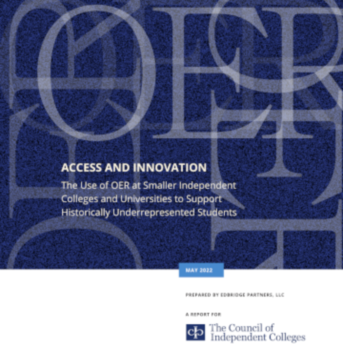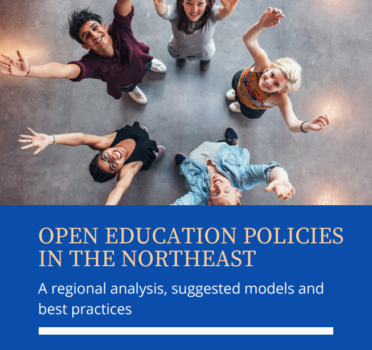What we’re reading about Open Education:
 Access and Innovation: The Use of OER at Smaller Independent Colleges and Universities to Support Historically Underrepresented Students
Access and Innovation: The Use of OER at Smaller Independent Colleges and Universities to Support Historically Underrepresented Students
The Council of Independent Colleges
June 2022
This project focused on those institutions that serve historically underrepresented student populations in higher education, such as students who identify as Black or African American or Latinx, students who are the first in their families to pursue a postsecondary education, or students from low-income households.
Open Education Policies in the Northeast
Lindsey Gumb, Fellow for Open Education
December 2020
While there is no one-size-fits-all policy, model or practice in Open Education, several New England states engaged in this work have identified and demonstrated practical approaches to successfully advance initiatives at both the state and institution level. This regional analysis shares exemplars and observations of sound practices observed by NEBHE Fellow for Open Education, Lindsey Gumb.
Read report
 Gap Analysis and Environmental Scan:
Gap Analysis and Environmental Scan:
Sharing Observations, Priorities, Opportunities in the National OER Landscape
NEBHE, MHEC, SREB, WICHE, & WCET
December 2020
The four regional education compacts—the Midwestern Higher Education Compact, the New England Board of Higher Education, the Southern Regional Education Board, and the Western Interstate Commission for Higher Education—are working together to help scale the adoption and use of open education resources nationally to allow millions students access to free, high-quality learning resources.
Affordability
Florida Virtual Campus Office of Distance Learning and Student Services conducted a large-scale study in 2018 to examine textbook affordability and the associated implications. Among the many key findings, notably the cost of textbooks negatively impacts student access to required materials and learning. The top 5 highest percentage answers as a result of the high cost of textbooks are: not purchasing the required textbook (64%); taking fewer courses (43%); not registering for a specific course (41%); earning a poor grade (36%); and dropping a course (23%).
Awareness
The 2020 Bayview Analytics and WCET report on OER suggests that while faculty and institutions have shown increasing awareness and acceptance of OER, “many remain unfamiliar with what they are, or how to utilize them.”
- Faculty who are aware of one or more OER initiatives are much more likely to be adopters of OER. This holds true for both faculty teaching introductory-level courses and the general population of faculty.
- When implemented at the institutional level, OER initiatives result in a measurable rise in the number of faculty who are aware of OER.
- Faculty who are aware of OER are much more likely to adopt OER as required course materials; those who have yet to adopt OER are much more likely to do so in the future.
- The impact of awareness of OER initiatives on adoption remains consistent across types of institutions (two- and four-year), the level of course being taught, and across regional compacts in the U.S.
Equity
The number of students reporting financial strain due to textbook costs have been found to be higher for first-generation, Pell and other underrepresented groups of students. A 2020 study (n=705) conducted by Jenkins et al. found that Latinx students were three times more likely than their white peers to fail a class because they could not afford the textbook, and first-generation students were twice as likely to fail a course than their non-first generation peers for the same reason.
A 2018 paper by Sarah Lambert offers a new social justice aligned definition for Open Education, providing us with new shared language and a strong theoretical framework to distinguish the field of Open Education from constructivist eLearning. Lambert offers us three new “R’s”to define the principals of social justice in Open Education: redistributive, recognitive, and representational.
A 2018 study by Colvard, Watson & Park found that “… OER adoption does much more than simply save students money and address student debt concerns. OER improve end-of-course grades and decrease DFW (D, F, and Withdrawal letter grades) rates for all students. They also improve course grades at greater rates and decrease DFW rates at greater rates for Pell recipient students, part-time students, and populations historically underserved by higher education.”
Inclusive access
Like OER, inclusive access models aim to ensure that all students have access to their learning materials on day one of class, but the major difference is that OER are free and inclusive access is not. Colleges and universities sign inclusive access contracts with publishing companies that then add the materials cost directly to the student’s tuition bill, also known as “automatic textbook billing.” In February 2020, U.S. PIRG Education Fund reviewed 31 of these such contracts across the country affecting more than 700,000 students and issued a report revealing a significant amount of the contracts “fail to deliver real savings for students, reduce faculty and student choice, and give even more power to a handful of big publishing companies.”
Pedagogy
In a 2023 study on renewable assignments, Clinton-Lisell & Gwozdz found that students reported significantly higher levels of representational justice for renewable assignments, indicating that they noted more opportunities to share their stories and speak from their experiences in these projects than with traditional assignments. Students also reported significantly higher levels of intrinsic motivation (inherent interest and enjoyment) with renewable assignments vs. traditional assignments, and traditional assignments had significantly higher levels of reported associated pressure vs. renewable assignments.
John Hilton III, et. al (2019) published a study on the perceptions of 173 students enrolled in courses using various approaches to open pedagogy by nineteen instructors in post-secondary institutions in New Hampshire. Students found value in open pedagogy and believed that open pedagogy had greater overall educational value than traditional educational activities. One student shared that open pedagogy “allowed me to look through important course information, such as cases and related legal information, and synthesize it for the audience (my blog). This forced me to think of the information in terms of its importance relative to my topic and use it in a way that was meaningful to an audience that may not have the context to digest a lot of raw information. A traditional tool, like a test or quiz, would not achieve this same level of cognitive rigor in terms of how I used the course material.”

